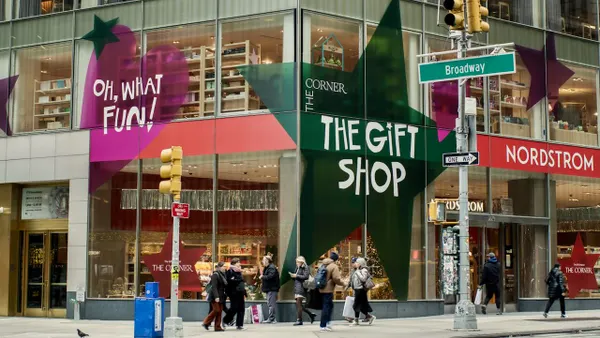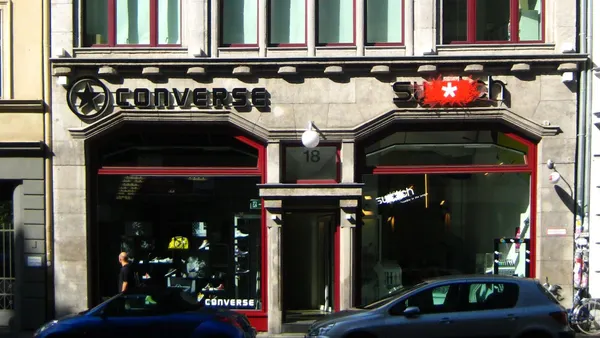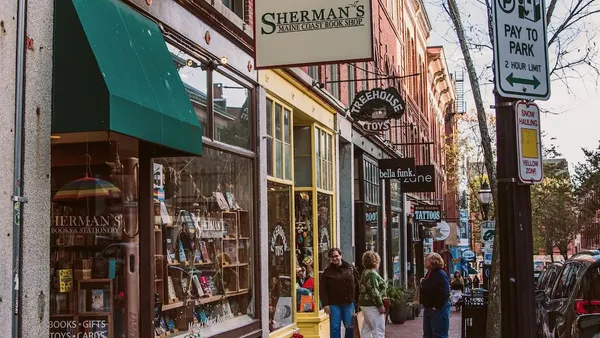UPDATE: December 31, 2018: In a statement on Friday, an affiliate of ESL investments, Transform Holdco, confirmed it submitted a $4.4 billion bid for nearly all of Sears' remaining assets, including 425 stores. The bid included $1.3 billion in proposed financing from three investment banks. If the bid is accepted, Transform said it expects to employ 50,000 associates and reinstate severance protections for eligible employees going forward.
Dive Brief:
- Just under the wire on Friday afternoon, Sears Holdings Chairman Eddie Lampert submitted a bid for the ailing retail company through an affiliate of ESL investments, Transform Holdco,CNBC first reported. The company, which runs the Sears and Kmart banners, faced a deadline of 4 p.m. Friday for any bids that might save the iconic retailers from liquidation. Sears Holdings declined to comment to Retail Dive on the report.
- Sears Holdings on Friday also gave notice to the U.S. Bankruptcy Court of the Southern District Of New York of the closure of 80 stores, five Sears Auto Centers and one distribution center, according to documents filed by the company's debtors and debtors in possession.
- Sears Holdings filed for Chapter 11 in October and has reportedly entertained the possibility of liquidation in recent weeks as Lampert, whose hedge fund has propped up the retailer in recent years, submitted plans deemed untenable by creditors.
Dive Insight:
Lampert's last ditch move on Friday, "makes liquidation a little less likely ... [but] Sears is a broken company and there is no clear pathway to it becoming profitable again," GlobalData Retail Managing Director Neil Saunders told Retail Dive in an email.
In fact, it was Lampert who broke it, Saunders also said. "Lampert broke the company over many years and at the same time continually promised to fix it," he said. "The latest bid is a continuation of that old narrative and like the boy who cried wolf, the message is not particularly believable."
For a while on Friday, it looked like Sears would attract no bids, and the fact that it failed to attract one outside of Lampert's domain is a sign that Sears, once an iconic retailer at least as disruptive as Amazon and as ubiquitous as Walmart, holds little value, he said.
"The fact that Lampert was the only bidder says a lot," Saunders said. "If there was some residual value in Sears, other investors would have spotted it and likely made a move. They don’t, and it only makes sense for Lampert to bid because he is already heavily invested in Sears."
Sears' advisors have until Jan. 4 to deem Lampert's hedge fund, ESL Investments, a "qualified bidder" or not, according to CNBC's report, leaving the saga to drag on. "We will need to wait until the new year to see whether Lampert’s rumored bid is accepted," Saunders said, adding that as advisors "weigh up whether the bid is worth more than liquidation; in my view Sear is still on life support and survival is touch and go."
The company holds little allure because it's "not only ... deeply unprofitable, but it also suffers from a tarnished brand and the lack of a clear proposition," Saunders also said in a note emailed to Retail Dive. "This means any purchaser would need to undertake both severe financial engineering as well as brand reinvention — a costly and risky process with little guarantee of success."
That financial engineering over the years has included several infusions from Lampert's hedge fund, ESL Investments, of millions of dollars in loans, making him a creditor as well as the chairman and (for a while, the CEO). He is also the chairman of Seritage Growth Properties, the real estate investment trust established in 2015 mainly from Sears properties; as Sears has sold much of its valuable real estate to the REIT, it owes rent on those same locations, pressuring them further.
In fact, Saunders called the latest round of closures a "last roll of the dice" that will, once again, do little if anything this time around. "While closure sales have helped to temporarily boost footfall and revenue at some shops, they have done nothing to put the firm on a sound footing," he wrote. "Nor have the efforts improved perceptions. Our data from the holiday period show that overall customer usage of both Sears and Kmart has fallen, and perceptions of both brands are down on last year's low scores. In our opinion, this is a brand now at rock bottom."
With Lampert pulling various money levers but doing little to invest in stores or any retail fundamentals, the business has been more of a financial Rube Goldberg machine than a retail enterprise. "This convoluted financial scheme that he created, all of its tentacles that he was able to use to extract from that once great brand, in the end who suffers? The employees suffer," Bob Phibbs, CEO of retail consultancy The Retail Doctor, told Retail Dive on Friday as the deadline approached. "Let’s be honest — these are stores that have been neglected for years."
The possible liquidation of Sears and Kmart has been anticipated for a while now as the retailers have for years shuttered stores, sold off iconic private labels, spooked vendors and tried investors' patience. In addition to the employees left without work, the ongoing closures will likely mean a death sentence for many C and D malls, Phibbs also warned.
But don't blame Amazon, he said, as he also wrote earlier this month. "These retailers haven’t made money in a long time," he said Friday. "All [Lampert] did was load these companies with debt. All the fees and all of the outrageous bonuses all these years, picking the bones [off] this once great retailer."
There's a chance that the "Sears" name might ultimately be picked up at auction, so that a vestige of the brand could continue online, according to Saunders. "Such an outcome would be a dispiriting end to a once iconic retailer," he said.












